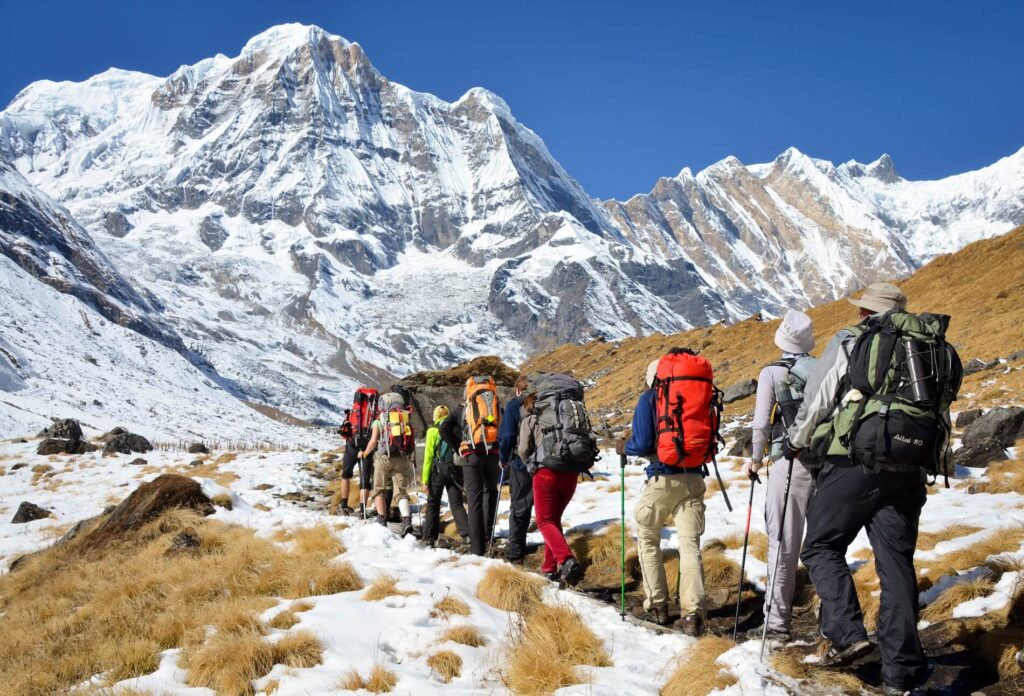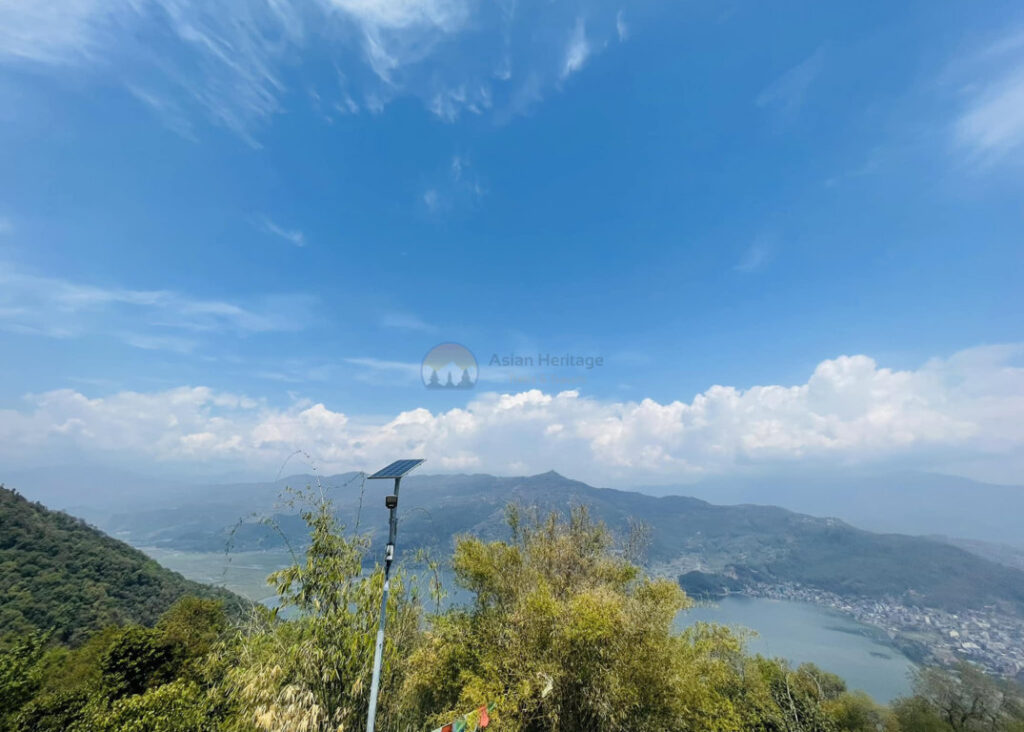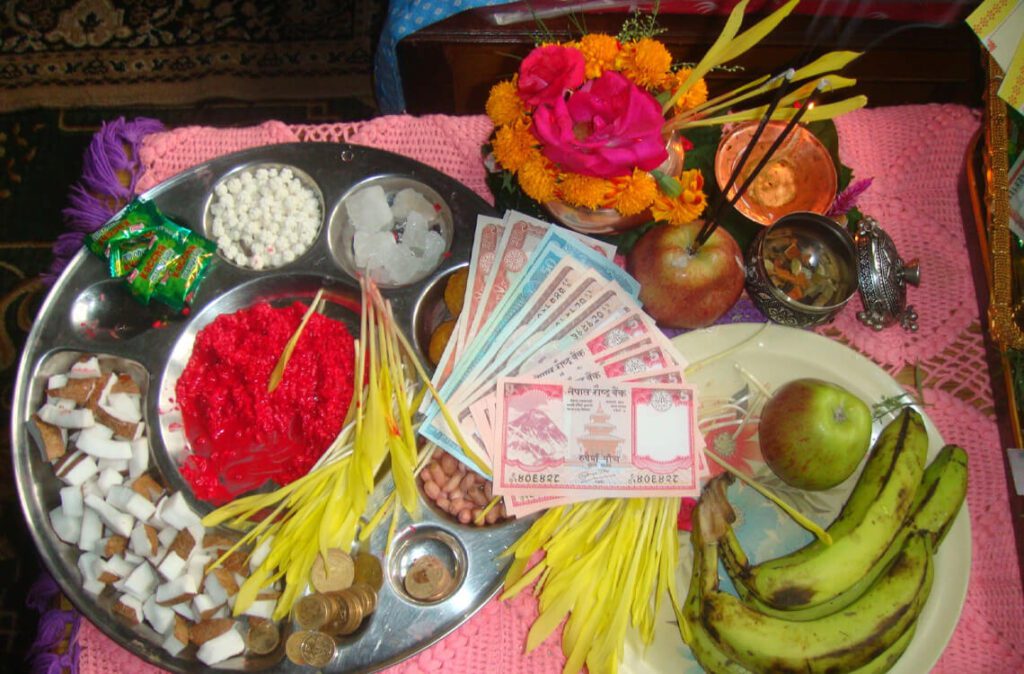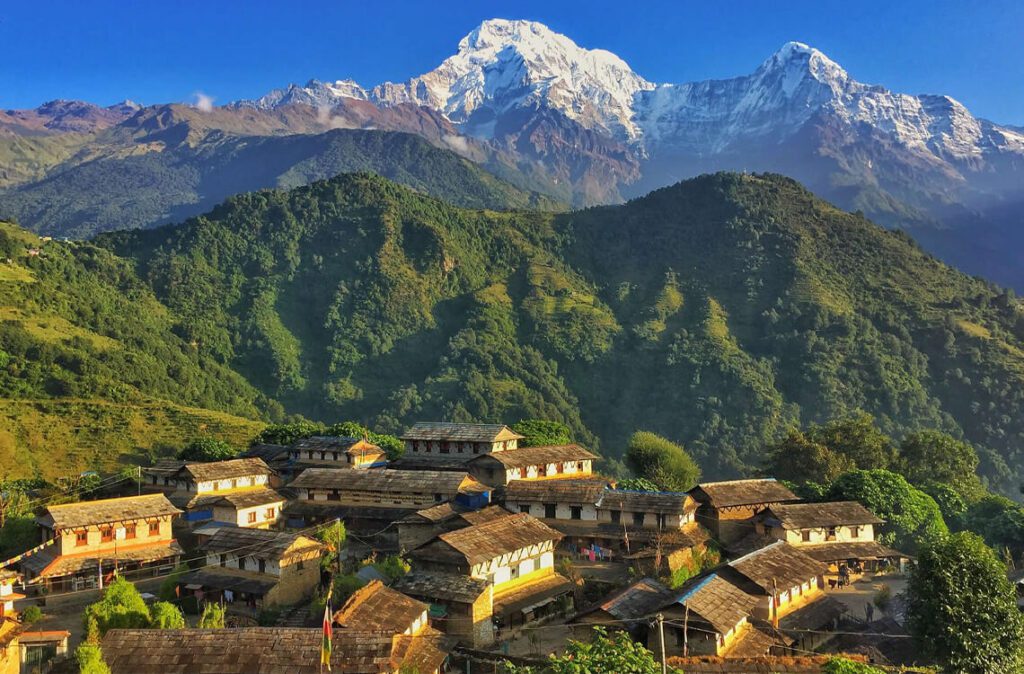Are you ready to unleash your inner adventurer and conquer the Himalayas? The Annapurna Base Camp trek in September is the ultimate thrill-seeker’s dream come true! This epic journey will take you on a heart-pumping adventure through lush valleys, over raging rivers, and up to the base of one of the world’s most iconic mountain ranges.
With September being the perfect time to trek, you’ll enjoy moderate temperatures, clear skies, and refreshing mountain breezes as you explore the Annapurna region. The monsoon season will have subsided, leaving behind verdant green landscapes, blooming flowers, and an opportunity to explore nature at its most exhilarating.
Weather Condition of Annapurna Base Camp Trek in September
The trek to Annapurna Base Camp is a well-known hiking route in Nepal that offers awe-inspiring vistas of the Annapurna Mountains. With clear skies, pleasant temperatures, and stable weather September is a favored time to embark on this adventure as it falls in the autumn season.

In September, Annapurna Base Camp typically enjoys dry and sunny weather with occasional clouds. During the day, temperatures hover between 10°C to 15°C whereas nighttime temperatures may dip below freezing, particularly at higher altitudes. On average, the temperature at Annapurna Base Camp in September is around 12°C (54°F).
Although people generally consider September a good time to trek in the Annapurna region, there is still a possibility of rain and occasional snowfall, especially towards the end of the month. Therefore, it is important for trekkers to be prepared for sudden changes in weather and pack accordingly.
Location and Altitude
The Annapurna Base Camp Trek is situated in the Kaski region of Nepal which is one of the country’s 77 districts and is located in the province of Gandaki Pradesh. Kaski’s district headquarters Pokhara is also a renowned starting point for numerous hiking trails in the Annapurna range.
Also Read: Annapurna Base Camp Trek in August: The Perfect Adventure for Nature Lovers
The base camp positions itself at the foot of the Annapurna massif, which includes the world’s tenth-highest mountain, Annapurna I. At an altitude of 4,130 meters (13,550 ft) above sea level this base camp is located.
The crowd in Annapurna Base Camp Trek in September
People consider September a high season for this trek because of the end of the monsoon season and favorable weather conditions. During this time, the weather is usually stable with clear blue skies and great visibility. As a result, many trekkers plan their visit to Annapurna Base Camp during September leading to a significant crowd in the region.

During September, the crowd in Annapurna Base Camp can be quite large with trekkers from all around the world coming to witness the stunning views of the Himalayan range. The trekking route can get quite busy with many trekkers walking on the same trails, and staying at the same teahouses. This can sometimes lead to overcrowding, especially in the high season.
Despite the crowds, the atmosphere in Annapurna Base Camp can be quite festive during September. Many trekkers form groups and share their experiences and stories. The teahouses and lodges are usually bustling with people, and it can be a great opportunity to meet new people from different cultures and backgrounds.
Highlights of Annapurna Base Camp Trek in September
Pleasant Weather:
September marks the end of the monsoon season in Nepal and the weather starts to clear up. During the day, the temperature ranges from 10 to 20 degrees Celsius, making it comfortable for trekking. As the night falls, the temperature drops to around 5 degrees Celsius. The clear skies also offer stunning views of the mountains making it a great time to trek.
Stunning Scenery:
The Annapurna Base Camp trek is known for its incredible scenery which includes panoramic views of the Annapurna range. In September, the views are even more spectacular as the monsoon season has just ended, and the skies are clear. You’ll get to witness the snow-capped peaks, beautiful valleys, and dramatic landscapes. The trek also takes you through beautiful rhododendron forests that are in full bloom during this time of the year.
Lush vegetation:
September is the ideal time to appreciate the stunning vegetation that embellishes the Annapurna Base Camp hike. The area receives ample rainfall during the monsoon season which results in vibrant and beautiful plant life. The hike offers picturesque views of colorful trees, ferns, and flowers that add a vibrant touch to your journey. The rhododendron forests along the path are particularly enchanting in September and are not to be missed.
More: Annapurna Base Camp Trek in July
Cultural experiences:
The Annapurna region is home to various ethnic communities including the Gurungs, Magars, and Thakalis, each with its distinct culture and traditions. During your trip, you’ll have the opportunity to explore and experience their culture including their cuisine, language, and customs. Additionally, visiting nearby villages and interacting with locals will provide insight into their way of life. Along the route, you’ll encounter numerous Buddhist monasteries, stupas, and prayer flags, contributing a spiritual element to your adventure.
Comfortable Teahouse Trek:
The Annapurna Base Camp trek is a teahouse trek meaning you’ll stay in local lodges and eat in communal dining areas. In September, the lodges are not as crowded as during the peak season and you’ll be able to enjoy a more comfortable stay. The lodges provide basic amenities including a bed, blankets, and hot showers, making it a more comfortable and convenient way to trek.
Route of Annapurna Base Camp Trek
The route starts in the vibrant capital city of Kathmandu, where you can catch a bus or flight to the picturesque city of Pokhara, the gateway to the trek.
The trek itself begins at the trailhead in Nayapul, about an hour’s drive from Pokhara. From there, you’ll follow the Modi Khola river upstream passing through quaint villages, lush rice paddies, and dense forests of rhododendron and bamboo. The first night’s stop is at Tikhedhunga where you can rest and rejuvenate for the climb ahead. The next day, you’ll continue on to Ghorepani, a charming village perched atop a hill that offers stunning panoramic views of the Annapurna and Dhaulagiri mountain ranges.

On the third day of your trek, you will commence the most renowned part of the Annapurna Base Camp Trek. You will rise early and ascend to Poon Hill, a popular viewpoint with stunning views of the nearby mountain ranges during sunrise. After witnessing the awe-inspiring views, you will return to Ghorepani for breakfast before proceeding toward Tadapani. The trail passes through dense oak, bamboo, and rhododendron forests where you might encounter some wildlife.
Tadapani to Kathmandu
From Tadapani, the route descends through a dense forest before reaching the Modi Khola River. The trail then follows the river upstream passing through small villages and terraced fields of crops. After crossing the river, you’ll begin the steep ascent to the Annapurna Base Camp which sits at an altitude of 4,130 meters (13,550 feet). The views from the base camp are absolutely breathtaking, with towering peaks surrounding you on all sides. You can spend a day exploring the area before retracing your steps back to Pokhara.

The return journey is less strenuous, as you gradually descend through the same path you used to ascend. You’ll pass through some of the same villages and forests you saw on the way up but you’ll have a new perspective on the scenery as you head back down. You’ll end your trek in Nayapul where you can catch a bus or taxi back to Pokhara and eventually make your way back to Kathmandu.
Festival in Annapurna Base Camp in September
September is a wonderful time to visit Nepal as there are many festivals and events celebrated throughout the month. Here are some of the most important festivals celebrated in Nepal in September:
Indra Jatra:
In Nepal’s capital city of Kathmandu, Indra Jatra is a prominent celebration that spans eight days and holds significant importance. This festival commemorates Lord Indra, the rain deity, and is celebrated with colorful processions, musical performances, dance shows, and delicious feasts. It is one of the most notable festivities in Nepal.

Rishi Panchami:
Rishi Panchami is a festival that is celebrated on the fifth day of the bright half of the lunar month of Bhadra. It is a day dedicated to paying respect to the seven sages or rishis and is celebrated by fasting and performing rituals.
Bishwakarma Puja:
People celebrate Bishwakarma Puja on the fourth day of the dark half of the lunar month of Bhadra. They dedicate this day to the Hindu god of architecture and engineering, Bishwakarma. People offer prayers to Bishwakarma and celebrate with feasting and merrymaking.
Dashain:
Dashain, which usually falls in September or October depending on the lunar calendar, is one of the most important festivals celebrated in Nepal. It is a 15-day-long festival that celebrates the victory of good over evil. People in different parts of Nepal celebrate Dashain with diverse rituals and customs. They worship the goddess Durga in all her forms, exchange blessings and gifts, relish scrumptious food, and have family gatherings during this festival.

People observe fasts, offer prayers, and perform various religious rituals during the first nine days of the festival referred to as Navaratri. The most important day of the celebration is the tenth day, Vijaya Dashami, and people mark it by exchanging tika among family and friends. Tika symbolizes the significance of the occasion and is a combination of red vermillion, rice, and yogurt.
Flora and Fauna
In September, embarking on a trek to Annapurna Base Camp presents an excellent chance to immerse yourself in the marvels of nature. As you commence your journey, lush forests and fields adorned with a diverse array of wildflowers will envelop you.
Flora
The Annapurna Base Camp trek in September is a paradise for nature enthusiasts offering a wide range of plant species to discover. Moreover, several other alpine flowers are visible along the trail adding to the trek’s natural beauty.
One of the most commonly sighted flowers is the Himalayan blue poppy which the national flower of Bhutan is. These large, showy blue flowers can grow up to 1.5 meters tall and are found in the alpine regions of the trek. You can also spot a variety of daisies including the Himalayan daisy, which has bright yellow flowers and grows in rocky terrain. Another commonly sighted flower is the Himalayan primrose which has delicate pink or purple flowers and grows in meadows and rocky slopes.
You may also like: Annapurna Base Camp Trek in June
Apart from these flowers, numerous other alpine flowers can be discovered. For instance, the Himalayan bellflower, thriving in rocky terrain, displays blue or white bell-shaped flowers. Another beautiful flower, the Himalayan buttercup, features vibrant yellow petals and a black center. The Himalayan cobra lily which prefers damp habitats and has a distinctive hooded shape, is also observed.
Medicinal Plants
The Annapurna region boasts several medicinal plants, aside from the aforementioned flowers. The Himalayan nettle is one such plant that people use to produce tea and is known for its therapeutic properties. Another plant, the Himalayan rhubarb, has a renowned sour taste and people use it in traditional medicine to relieve digestive disorders.
Apart from their aesthetic appeal, the flora in the Annapurna region holds significant ecological value. Alpine flowers not only provide food and shelter for the local species but also contribute to preserving the area’s fragile environment. Remembering that these plants are delicate, and we must protect their ecosystem and avoid disturbing them while hiking is crucial.
Fauna
The Annapurna region is home to numerous animal species, and September presents an excellent opportunity to witness some of them. Below are a few examples of species you might encounter during your hike.
The Himalayan Tahr, one of the iconic animals that reside in ABC, has thick and shaggy hair that helps it stay warm in high altitudes and often grazes on the flora that grows on the steep slopes of the Annapurna region.

Another rare and elusive animal that enthusiasts can spot in the Annapurna region is the snow leopard.
These majestic creatures have highly adapted to the harsh conditions of the Himalayas and have gained renown for their ability to blend into their surroundings. While it is rare to spot a snow leopard, September is a good time to search for them as they descend to lower altitudes in search of prey.
The Himalayan Musk Deer is another remarkable species that people can observe in the Annapurna area. People often observe these small and shy creatures, known for their musky scent used in perfumes and traditional medicine, as they forage for food in the wooded areas of the region.
Pheasant Species
The Himalayan Black Bear is another animal that people can spot in the Annapurna region. These bears have black fur and distinctive white chest patches. People usually find them in the higher altitudes of the region, where they can see them foraging for food in forested areas.
One of the most adorable animals people can spot in the Annapurna region is the Red Panda. These cute and furry creatures, which have a small population in the Annapurna region, are a rare sight. People usually spot them in the forested areas of the region, where they climb trees and forage for food.
The Annapurna region is also home to several pheasant species including the Himalayan Monal, Koklass, and Kalij. You can see these vibrantly colored birds flying through the air or perching on trees in the region’s wooded areas.
Side Treks
Here are some of the most popular side treks in the Annapurna Base Camp Trek:
Poon Hill:
Poon Hill is a renowned trek that is often taken at sunrise which takes about an hour from Ghorepani and sits atop a hill above the town. The summit offers stunning views of the Annapurna and Dhaulagiri mountain ranges along with other peaks in the vicinity.

It is also a great spot for taking photographs. Numerous trekkers choose to spend the night at Ghorepani and hike to Poon Hill in the morning before proceeding on the primary path to Annapurna Base Camp.
Hot Springs:
If you need to relax and soothe your tired muscles after a strenuous day of trekking, the hot springs in the Annapurna region are a wonderful option. Among the popular hot springs, Jhinu Danda and Tatopani stand out. Jhinu Danda is situated on a hill above the Modi Khola River, about a two-hour climb from Chomrong. Meanwhile, the hot springs in Tatopani are located in the village of the same name which is about a day’s journey from Jhinu Danda.
Machhapuchhre Base Camp:
The Machhapuchhre Base Camp is located at an altitude of 3,700 meters and is approximately a day’s hike from Bamboo. Although the journey to the base camp is more challenging than some of the other side trips, the stunning view of Machhapuchhre Peak from there makes it worthwhile.
Ghandruk Village:
Ghandruk is a traditional Gurung village that is about a half-day hike from Chomrong. The village is situated on a hill and offers stunning views of the Annapurna and Machhapuchhre mountain ranges. You can visit a Gurung museum and learn about the local culture, visit the village temple and even stay overnight in a homestay to get a closer look at the local way of life.

Merits and Demerits
Below are some of the merits and demerits of doing the Annapurna Base Camp Trek in September:
Merits
- Good weather conditions: September marks the end of the monsoon season in Nepal and the weather becomes relatively dry and clear. The rain and fog that can obscure the views during the monsoon season subsides allowing for better visibility of the surrounding mountains. This means that trekkers can expect comfortable trekking conditions with clear blue skies and mild temperatures.
- Beautiful scenery: The beautiful scenery at Annapurna Base Camp Trek offers breathtaking mountain views, and September provides an excellent time to witness these views. Lush green forests, colorful wildflowers, and several rivers and waterfalls surround the trekking trail, making it a perfect place for nature lovers. Trekkers can also enjoy the spectacular sunrise and sunset views over the Annapurna and Dhaulagiri mountain ranges.
- Blooming flora: The monsoon season brings new life to the forested areas along the trek and in September, the flowers are in full bloom. Trekkers can witness the colorful primroses and other wildflowers, making the trek even more beautiful.
- Affordable prices: Since September is the off-season for tourism in Nepal prices for accommodation, food, and trekking gear tend to be lower than during the peak season. This makes the trek more affordable for budget-conscious travelers.
DEMERITS
- Risk of rain: Although September marks the end of the monsoon season there is still a chance of rain during the trek. This can make the trail slippery and muddy making it challenging to navigate. Trekkers should prepare themselves with appropriate gear, such as waterproof jackets and hiking boots, to protect themselves from rain and mud.
- Cold temperatures: September is the start of the autumn season and temperatures can drop significantly during the night, especially at higher altitudes. Trekkers should have the proper gear to stay warm such as warm jackets, fleece jackets, and sleeping bags.
- Unpredictable weather: Weather patterns in the Himalayas can unpredictably change, and trekkers should prepare for sudden weather conditions changes like heavy rain or snowfall. It’s essential to stay updated on weather forecasts and plan accordingly.
- Altitude sickness: The altitude of 4,130 meters situates Annapurna Base Camp, and trekkers can experience altitude sickness. Trekkers should take proper precautions to acclimatize themselves to the high altitude such as taking rest days and drinking plenty of water.
Let our expert team at Asian Heritage Treks and Travel take care of everything — from guided tours to personalized packing tips and travel arrangements.
Plan My Annapurna Trip







